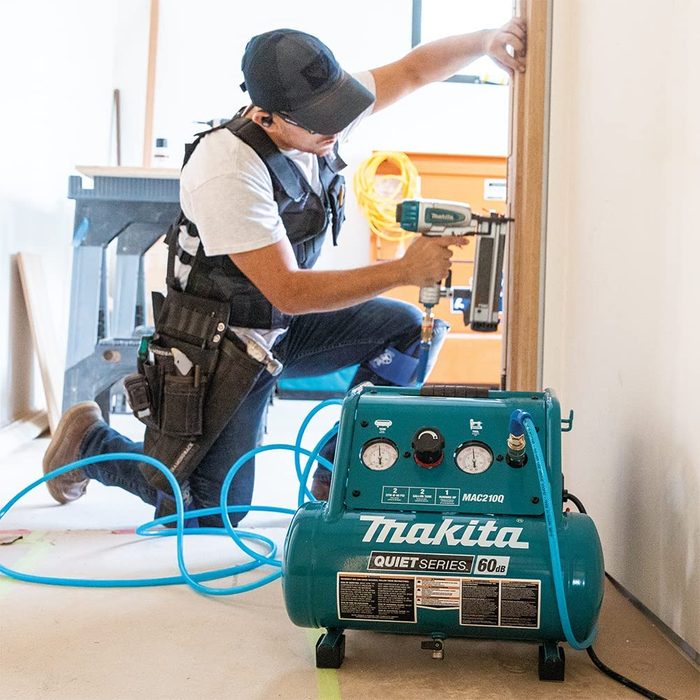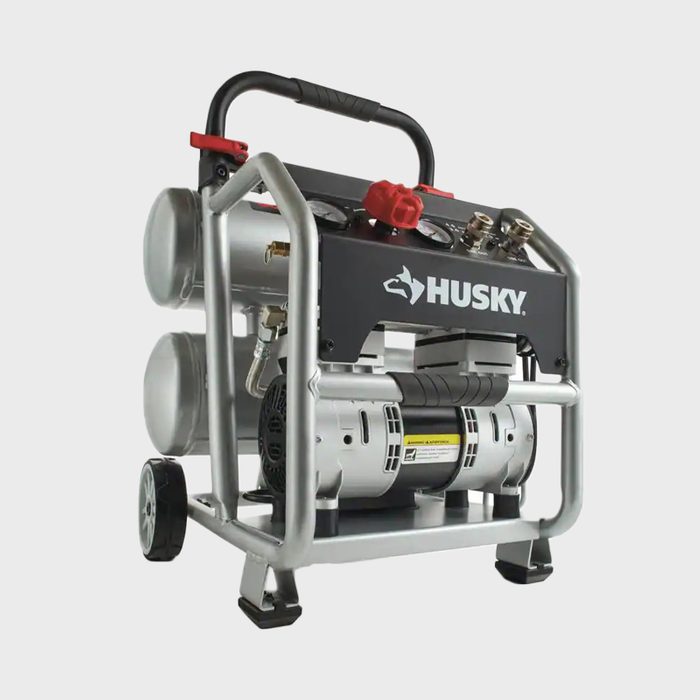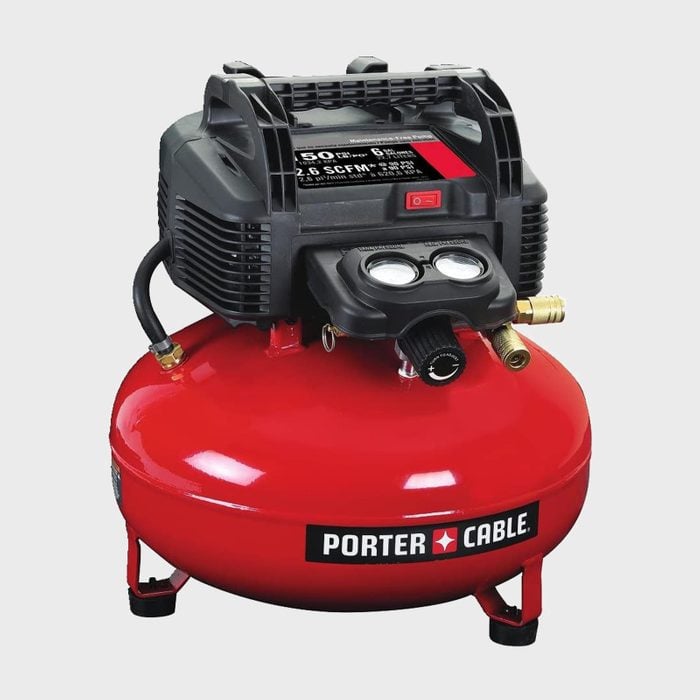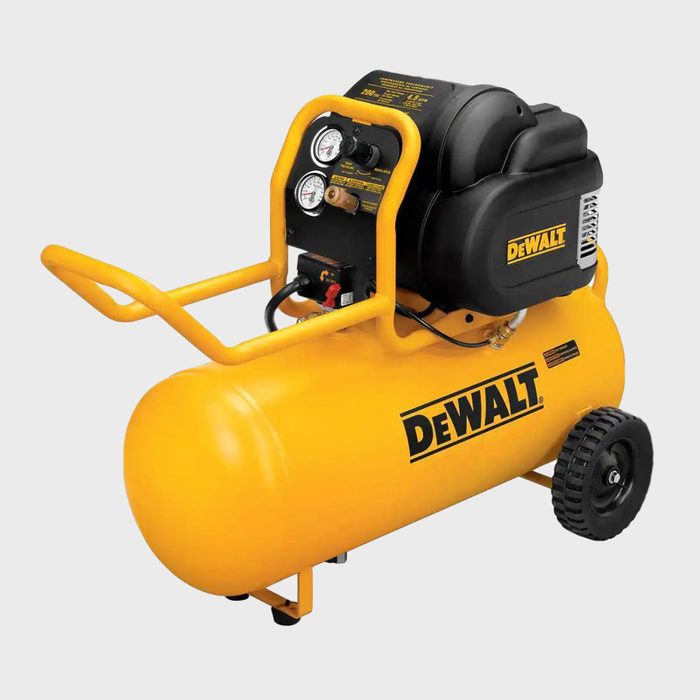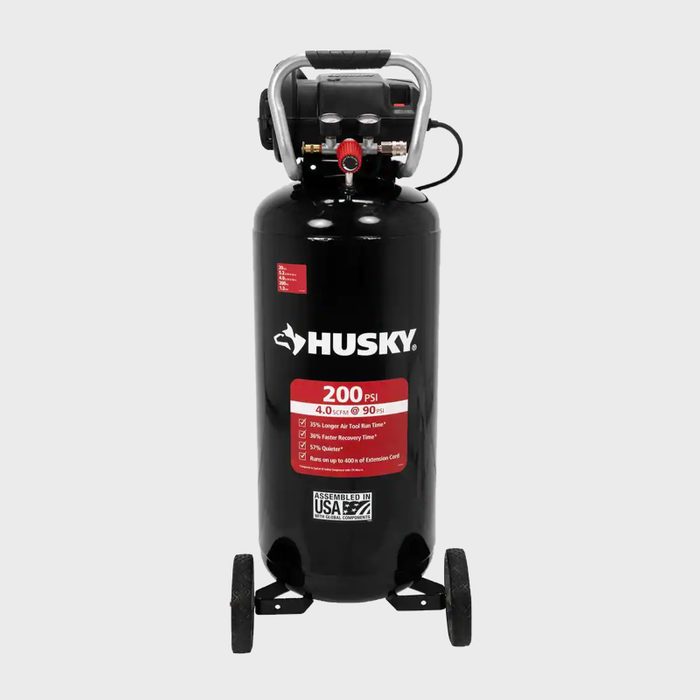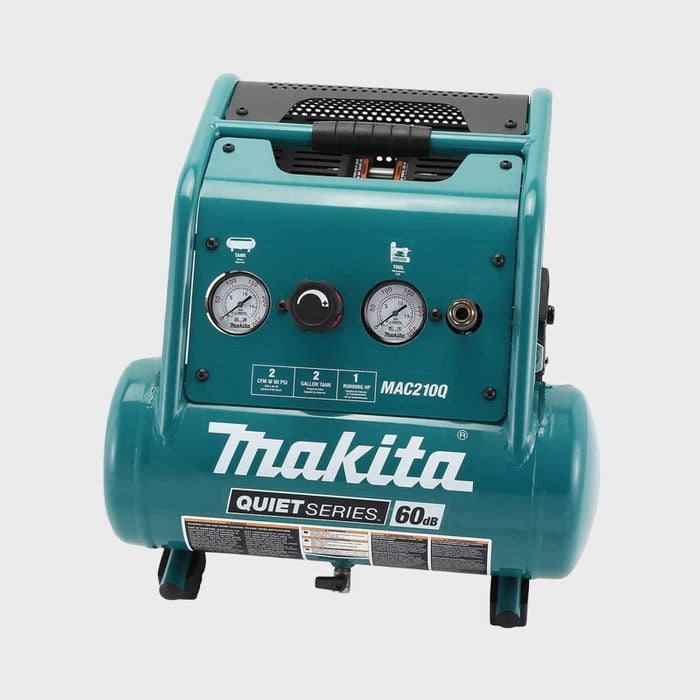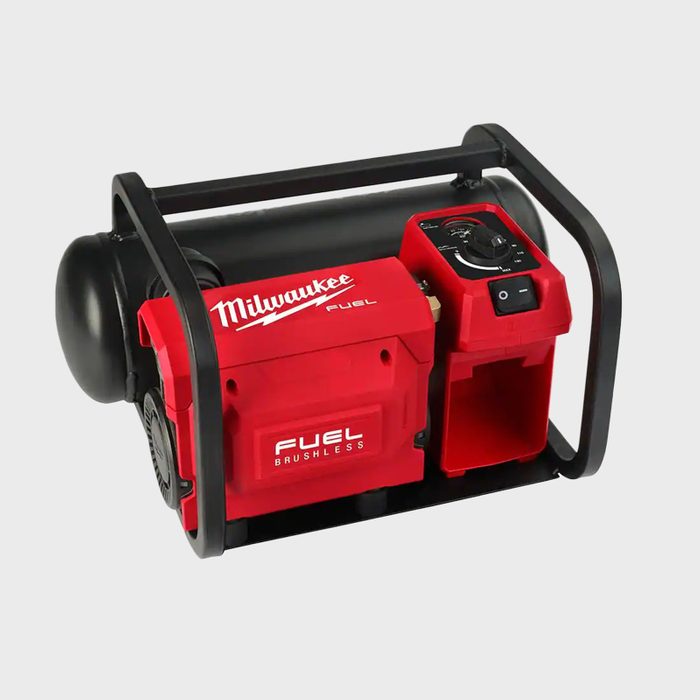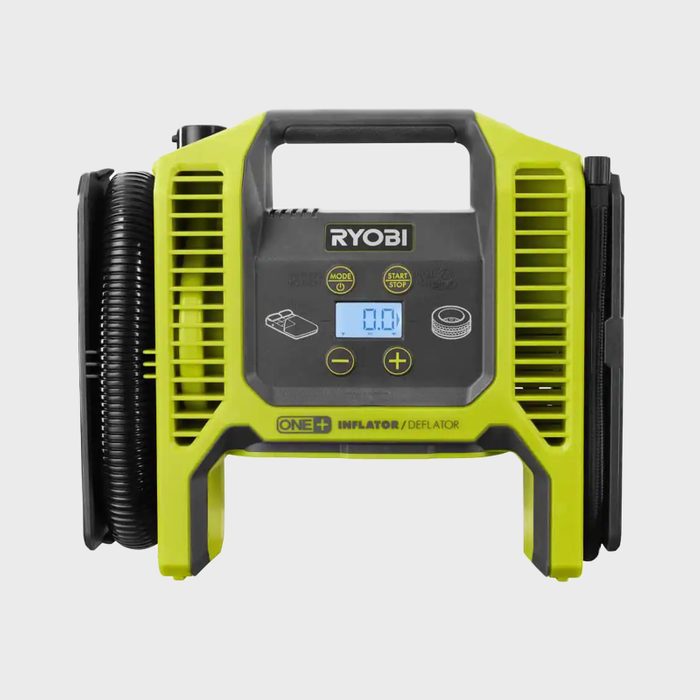


Buying an Air Compressor
Air compressors power everything from nail guns to paint sprayers and tire inflaters. They’re tremendously popular among professional carpenters, roofers and mechanics. DIYers love them for the affordable pricing and mobility, although both considerations vary by model.
Here are some key terms and features to know about when shopping for an air compressor:
Style. While the basic technology behind DIY-grade air compressors is relatively standard, they come in multiple styles:
- Standing (or vertical) air compressors are the least mobile. They’re favored by DIYers who use their compressor in a single location, such as a wood shop or automotive garage.
- Wheelbarrow compressors are mobile and sit horizontally when in use, just like a wheelbarrow. These are usually marketed to pros who need to wheel a high-powered compressor around a large jobsite.
- Hot dog compressors have horizontal, cylindrical tanks often mounted on wheels, but aren’t large enough to resemble a wheelbarrow.
- Pancake compressors are flatter and rarely have wheels. They’re good for carrying inside a house, perched on a roof, or an other location they shouldn’t roll around.
Size (volume). Compressors are labeled by the size of their storage tank, in gallons. Standing tanks offer the largest storage, while hot dog and pancake compressors typically have the least.
Noise. Overall, compressor noise has dropped significantly in recent years, but not all manufacturers consider it a priority. You may need to do a little digging to find the noise level for a given model. Look for a rating measured in decibels (dB). Many manufacturers spec their compressors using dBA, a decibel rating weighted against an average child’s hearing range. For our purposes, we’ll treat dB and dBA as interchangeable.
Hose Couplers. Air compressors connect to tools through an air supply hose. The hose connects to the tank by a coupler, typically a quick-connect (sometimes called quick-release) coupler that allows the hose to easily slip on or off the compressor. Some compressors come with a single coupler, while others have two or more. If you think you’ll only be working with a single tool, this won’t matter much. However, if you’ll change between multiple tools frequently, having both hooked up to the compressor is a great time saver.
SCFM and psi. The two primary performance metrics for air compressors are airflow and pressure. Airflow is measured in standard cubic feet per minute (SCFM) and pressure in pounds per square inch (psi). Which one is more important depends on what you’ll be doing. Inflating tires takes steady airflow but not much pressure, while firing a nail gun requires a short burst of high pressure air. Most DIY compressors will max out between 100 and 200 psi. The SCFM will be 2 or 3 for small air compressor units, and up to 7 to 10 for large vertical or wheelbarrow compressors. Check your tools to see what SCFM and psi they require, then look for a compressor that can exceed them by 10 to 30 percent. Ideally, the compressor manufacturer will list the SCFM at a specific PSI.
Oil-lubricated vs. oil-free. The fast piston-action of an air compressor generates a lot of friction. All compressors need lubrication to control the temperature. Some use oil, but oil-free compressors use specially coated parts to reduce friction. Oil-free units are nice because they don’t require oil top-offs or filters. There’s a whole debate to be had about which is better, but the reduced maintenance of oil-free compressors makes them the better choice for most DIYers. All the compressors on this list are oil-free.
Power source. Air compressors can be corded electric, cordless electric and gas-powered. Almost all models geared to a typical DIYer’s budget and needs are corded electric. Gas-powered compressors are expensive and can only be operated outdoors; pay the premium only if you frequently working in locations without electric service. There are a few cordless options for DIYers, and we’ve included a pair of noteworthy examples on this list.
Cost. For the smaller, portable models that many DIYers favor, a budget of $125 to $300 is reasonable. A larger vertical or wheelbarrow compressor runs from $300 to $900.

Best Hot Dog Air Compressor
Hot dog compressors are portable and powerful. The 4.5 gallon Husky 3320445 Air Compressor ($239) delivers 3.0 SCFM at 90 psi and maxes out at 175 psi. This Husky has two air hose couplers and operates at 65 dB, making it one of the quieter compressors on this list.
The adjustable handle and rubber wheels help if you’re working a single-floor job or moving it around a garage or basement.

Best Pancake Air Compressor
There are plenty of pancake compressors on the market. The Porter Cable C2002 Air Compressor ($112) edges out the competition with a balance of performance and affordability. It maxes out at 150 psi and delivers 2.6 SCFM at 90 psi.
We’re not as crazy about the operating volume (78 dB), which is a little high but not a deal-breaker. It has a pair of hose couplers, and the rubber feet keep it from scuffing the floor. It weighs 30 pounds and maneuvers easily, making it a great choice for carrying up and downstairs.

Best Wheelbarrow Air Compressor
Rugged, reliable and highly mobile, wheelbarrow air compressors are often marketed to pros, with corresponding prices (often more than $1,000!). If you’re a DIYer who likes the wheelbarrow form, consider the DeWalt DD55167 Air Compressor ($418)
Its maximum 200 psi is higher than most DIY-grade compressors, as is the 4.8 SCFM at 90 psi. It has a 15-gallon tank and runs at 78 dBA. It ships with a single hose coupler, integrated handle and a pair of wide-track tires that make moving the air compressor over cords and uneven surfaces a breeze.

Best Vertical Air Compressor
Vertical air compressors are often less mobile than other types. Some are not portable at all. We like the Husky C202H Air Compressor ($329) as a good fit for most DIY needs.
It’s not nearly as large as some pro-grade vertical compressors, but its price tag isn’t nearly as large, either! And for DIY use it still packs plenty of punch, with 200 max psi and 4.0 SCFM at 90 psi.
We love that this 20-gallon compressor is mounted on seven-inch wheels, and the 81 dBA is reasonable. One nice feature: The manufacturer says the motor will start in conditions as cold as minus-20 F, making it a great choice for unheated garages.

Best Low-Volume Air Compressor
Sometimes it can be tough to identify a leader in a specific element. Other times, it’s right in the product description. That’s why we love the Makita Quiet Series MAC210Q Air compressor ($199).
Currently, there are three models in Makita’s Quiet Series. This is the middle one, offering a good balance of price, size and volume. If you want the compressor to run less often and don’t mind a price increase, step up to the MAC320Q. If you’ll use it in short bursts and want to keep the noise down, consider the MAC100Q.
The MAC210Q generates 60dB, roughly comparable to a conversation in a restaurant, so it’s ideal for indoor use. It also has a full roll cage to protect it from the inevitable drops and dings.

Best Overall Value Air Compressor Combo Kit
One of the best entry-level air compressor and accessory package we’ve seen is this DeWalt PCFP12236 Air Compressor, Nailer and Hose Kit ($169). There are competing products around the same price, but this one edges the others by providing higher-quality equipment for just a little more money.
The six-gallon pancake compressor is the same model we featured earlier, maxing out at 150 psi and 2.6 SCFM at 90 psi. The combo kit adds in a Porter Cable 18-gauge brad nailer, 25-foot air hose and 100 brad nails.

Best Cordless Air Compressor
Cordless air compressors are still relatively new to the market, but one of the first standouts is the Milwaukee M18 Fuel Quiet Air Compressor ($350). We love that this two-gallon compressor runs at only 68 dBA and it’s compatible with other tools in the M18 battery line, most notably their nail guns.
It does have less power, however, maxing out at 135 psi and an anemic 1.2 SCFM at 90 psi. But if you’re working away from electricity or don’t want to trip over power cords, it’s a great option.

Best Cordless Inflator Air Compressor
Sometimes you don’t need to frame a roof, you just need to put a little air in your tires. In that case, wheeling a $300 compressor and extension cord out of your basement probably feels like overkill.
The Ryobi P747 Cordless Inflator/Deflator Air Compressor ($60) is so lightweight and compact it can even be stored in your car to pump up your tires. It’s also great for cleaning, or inflating mattresses, rafts and toys.
Sure, your pancake compressor can do the job just as fast. But you don’t often have an outlet handy when you need to inflate a flat tire.
All prices and links were current as of publication.
Did you miss our previous article…
https://tophouseimprovement.com/how-to/why-you-shouldnt-get-rid-of-your-old-tv-cables/
